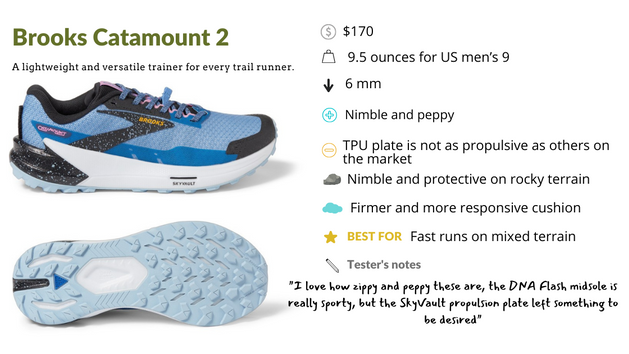First Look: Brooks Catamount 2
This article originally appeared on Trail Runner
I loved the OG Brooks Catamount. Lightweight and ready to rally on a reasonably wide variety of trails, the sneaker-like construction was a breath of fresh air compared to (in my opinion) some slightly overbuilt trail shoes of late. In sum: I like the Catamount 2 even more than the original, though it runs like a completely different shoe. Our take: fans of the original Catamount will like the updates, and the new-and-improved version might convert some new runners, too.

RELATED: The Trail Running Shoes We're Most Excited to Try in 2023
Meet the Brooks Catamount 2
The Upper
Some of the Catamount 2's biggest improvements are in the upper. An engineered mesh outer with a more structured overlay provides a little more security than the first Catamount, without feeling overbuilt or heavy. A gusseted tongue and softer interior liner hug the foot, making it feel less wobbly on tight turns and in technical terrain while reducing friction points (and potential blisters). The forefoot feels wider than the previous model, which will be a relief to many runners who found the first Catamount a tad snug.
The fit feels true to size, if more forgiving than its predecessor. It also features a reinforced toe bumper to make the upper more durable. A gaiter trap can lock down extra foot protection, and a lace loop will help make sure your shoes stay tied for the long haul.
RELATED: The Gear Trends our Editors are Watching in 2023
The Outsole
Another major update in the Catamount 2 is an adjusted lug pattern for vastly improved handling in technical and wet/muddy terrain. Multiple lug shapes at an angle give the outsole more bite, and the TrailTack rubber (also used in the Divide 3) is a much tackier rubber than the original. The adapted lug spacing also allows for more flexibility through the midfoot, so you have decent trail feel without a ton of rigidity. Even after 100+ miles on wet and muddy terrain, our tester's pair still runs like new.
RELATED: Our Five Favorite Winter Trail Running Shoes in 2023
The Midsole
Another standout feature of the Catamount 2 is the DNA Flash midsole, a nitrogen-infused EVA material that's ultra peppy. Nitrogen-infused foams tend to last longer than their oxygen counterparts because nitrogen is a smaller element than oxygen and leaks out of the foam less quickly--making those foams feel more responsive and peppy for longer.
The 22mm heel stack height and 6mm drop is forgiving for those of us with picky plantars and achilles, without feeling chunky. A slightly denser durometer foam in the heel helps absorb impact on the downhills, which is nice for days when you're pounding serious vert.
RELATED: Here's What Our Editors Loved in December
The SkyVault plate (a multi-pronged, TPU plate) feels protective (though not overly rigid) through technical and rocky terrain, though it left a lot to be desired in terms of propulsion. Had I not known there was a plate present in the shoe, I probably wouldn't have guessed. Compared to other pronged plates like the Hoka TectonX, or the solid plate in The North Face's Flight Vectiv, the SkyVault can't quite keep up. It feels sporty because of the DNA Flash midsole, but not like hyper-responsive super shoes.
RELATED: The Best Trail Running Shoes of 2023
Takeaway
This is a great all-around shoe for someone who wants versatility and durability. It's well worth the $170 price tag if you want a do-everything workhorse that's ready to rally over rocks and roots, while also flirting with some speedwork on the singletrack, but it wouldn't be the first shoe I reached for if I really wanted the carbon-plate experience.
For exclusive access to all of our fitness, gear, adventure, and travel stories, plus discounts on trips, events, and gear, sign up for Outside+ today.